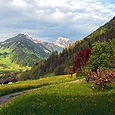MUSÉE
INTERNATIONAL D'HORLOGERIE – LA CHAUX-DE-FONDS
International Watchmaking Museum in Switzerland Jura
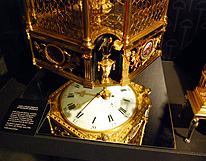 One
might ask the question, what separates the middle-ages from the age
of enlightenment? Is
it the printing press, the university, or is it
perhaps the clock? A clock appeared in Westminster in London about
1288. The first weighted clock about 1500. The watch mainspring about
1450
and the pendulum clock about 1650. The agrarian and the industrial
are separated by the management of time, and nowhere in the world is
this
more apparent the unique city of La Chaux-de-Fonds (pronounced rather
shodfond), in the Jura Mountains of Switzerland, between the French
border and Neuchatel. The Swiss did not invent the watch, but perfected
it and turned it
into an industry. The industry of watch making is still found here
and the
history of time keeping in the Musée International d'Horlogerie
(the MIH) or International Watchmaking Museum.
One
might ask the question, what separates the middle-ages from the age
of enlightenment? Is
it the printing press, the university, or is it
perhaps the clock? A clock appeared in Westminster in London about
1288. The first weighted clock about 1500. The watch mainspring about
1450
and the pendulum clock about 1650. The agrarian and the industrial
are separated by the management of time, and nowhere in the world is
this
more apparent the unique city of La Chaux-de-Fonds (pronounced rather
shodfond), in the Jura Mountains of Switzerland, between the French
border and Neuchatel. The Swiss did not invent the watch, but perfected
it and turned it
into an industry. The industry of watch making is still found here
and the
history of time keeping in the Musée International d'Horlogerie
(the MIH) or International Watchmaking Museum.
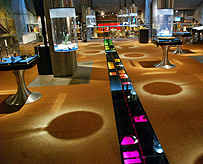 The watchmaking region of La Chaux-de-Fonds and its neighboring village
of La Locle have been named a UNESCO WORLD HERITAGE site for its place
in the history of watchmaking. The entire town is a form of museum,
built nearly from the ground up in the 19th Century to manufacture
watches,
with apartment houses-factories where watch technicians could work
at home on individual lathes and work stands with the light provided
through
windows facing the sun. The watch-making of famous elite brands like
Longines, Tag-Heuer, Patek-Philipe, Tissot, Hermes, Girard Perregaux
and Piaget
are still made here, but in more modern factories which cling to the
outskirts
of the
city.
The watchmaking region of La Chaux-de-Fonds and its neighboring village
of La Locle have been named a UNESCO WORLD HERITAGE site for its place
in the history of watchmaking. The entire town is a form of museum,
built nearly from the ground up in the 19th Century to manufacture
watches,
with apartment houses-factories where watch technicians could work
at home on individual lathes and work stands with the light provided
through
windows facing the sun. The watch-making of famous elite brands like
Longines, Tag-Heuer, Patek-Philipe, Tissot, Hermes, Girard Perregaux
and Piaget
are still made here, but in more modern factories which cling to the
outskirts
of the
city.
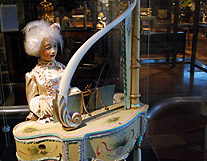 In
1865, the la Chaux-de-Fonds Horological School of watching making opened
its doors, and began a mission of building a collection of watches
for students to study and learn from the past masters of their craft.
The collection grew over 35 years, only to be seen by students and teachers,
until the city, inspired by French-Jewish watch-making industrialist
Maurice Picard opened the Horological Museum to the public. The International
Watchmaking Museum, now in a very modern building from 1980, houses one
of the world’s most extensive collection of time-pieces. Displayed
in suspended glass domes and among interactive time-lines and exploratory
stations, on four levels from the beginning of time-keeping to the atomic
clock and the Cern Collider, where even the separation of neutrinos tell
time (see Cern Collider Tours Geneva).
In
1865, the la Chaux-de-Fonds Horological School of watching making opened
its doors, and began a mission of building a collection of watches
for students to study and learn from the past masters of their craft.
The collection grew over 35 years, only to be seen by students and teachers,
until the city, inspired by French-Jewish watch-making industrialist
Maurice Picard opened the Horological Museum to the public. The International
Watchmaking Museum, now in a very modern building from 1980, houses one
of the world’s most extensive collection of time-pieces. Displayed
in suspended glass domes and among interactive time-lines and exploratory
stations, on four levels from the beginning of time-keeping to the atomic
clock and the Cern Collider, where even the separation of neutrinos tell
time (see Cern Collider Tours Geneva).
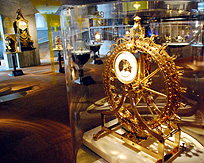 The
collection features some of the most ornate and fabulous examples of
clocks and watches, from the
world’s most complex watch movement to the smallest watch, a watch
made of wood, and gold gilt Baroque royal timepieces, music playing automatons,
marine chronometers, and robots. Works of designers like Pierre Jaquet-Droz,
Henry Grendon and Abraham Louis Brequet, to anonymous masterpieces. Hours
can be spent among the beauty and technological precision of the mastery
of art and time. View the restoration of historic pieces behind glass
by master craftsmen at the Centre of Restauration. Rotating exhibits
feature varying themes and the museum itself is buried in a hillside,
with a park above where the shining stainless steel of a modern Carillion
clock which tells time in digits and shifting panes of color on the quarter
hour, visible from the hillsides around town.
The
collection features some of the most ornate and fabulous examples of
clocks and watches, from the
world’s most complex watch movement to the smallest watch, a watch
made of wood, and gold gilt Baroque royal timepieces, music playing automatons,
marine chronometers, and robots. Works of designers like Pierre Jaquet-Droz,
Henry Grendon and Abraham Louis Brequet, to anonymous masterpieces. Hours
can be spent among the beauty and technological precision of the mastery
of art and time. View the restoration of historic pieces behind glass
by master craftsmen at the Centre of Restauration. Rotating exhibits
feature varying themes and the museum itself is buried in a hillside,
with a park above where the shining stainless steel of a modern Carillion
clock which tells time in digits and shifting panes of color on the quarter
hour, visible from the hillsides around town.
Visiting the Musée International d'Horlogerie La Chaux-de-Fonds
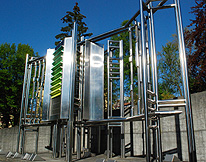 The museum is open from 10am to 5pm Tuesday to Sunday. Closed on Mondays,
Christmas and New Years. Admission is 15 CHF for adults, 12.50 CHF for
Consessions (Seniors), Students up to 25 years 10 CHF, and Children under
12 years are free. A family ticket is available and the museum is free
with a Swiss Pass. The Museum is located on Rue de Musee (Museum Street)
a 5 minute walk from the train station.
The museum is open from 10am to 5pm Tuesday to Sunday. Closed on Mondays,
Christmas and New Years. Admission is 15 CHF for adults, 12.50 CHF for
Consessions (Seniors), Students up to 25 years 10 CHF, and Children under
12 years are free. A family ticket is available and the museum is free
with a Swiss Pass. The Museum is located on Rue de Musee (Museum Street)
a 5 minute walk from the train station.
Visitors to La Chaux-de-Fonds can start at the Espace for Urbanisme Horloger,
just a block from the museum, which presents the story of the watchmaking
industry
that
built the town. Next
to the clock museum is the city’s history museum (currently under
a reconstruction), the local Freemason Hall and the Musee des Beaux Arts,
with samples of the city’s
connection to the Art Nouveau movement. The Musée d'Horlogerie
du Locle is a smaller clock museum in a former chateau in the neighboring
town. © Bargain
Travel Europe
Or
find best
travel deals for the
Jura on TripAdvisor
Web
Info
MIH
(in French)
These articles are copyrighted and the sole property of Bargain Travel Europe and WLPV, LLC. and may not be copied or reprinted without permission.
SEE
ALSO:
PATEK
PHILIPPE MUSEUM - GENEVA
BEYER CLOCK AND WATCH MUSEUM - ZURICH
BUCHERER ROLLING BALL CLOCK - LUCERNE
SWISS PUPPETRY MUSUEM – FRIBOURG

